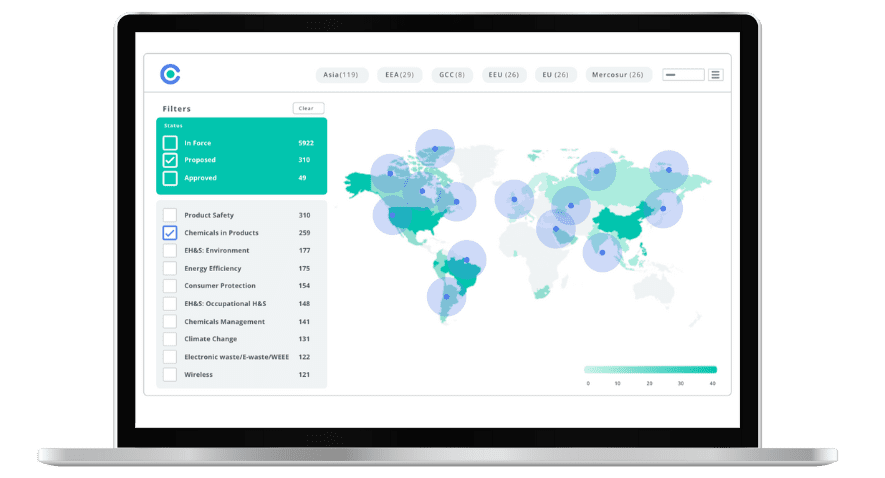
Chile’s Draft Strategy for a Circular Textiles Sector by 2040

This blog was originally posted on 10th September, 2024. Further regulatory developments may have occurred after publication. To keep up-to-date with the latest compliance news, sign up to our newsletter.
AUTHORED BY HANNAH JANKNECHT, REGULATORY COMPLIANCE SPECIALIST, COMPLIANCE & RISKS
Chile’s Draft Circular Economy Strategy for Textiles
On 22 August 2024, the Chilean Ministry of Environment proposed a Draft Circular Economy Strategy for Textiles. The strategy is part of a broader shift away from a linear economic model set out in the Roadmap for a Circular Chile by 2040. It aims to channel efforts to prevent the generation of waste, promote better quality garments and increase the reuse and recovery of textiles.
Textile Consumption, Import and Waste Management in Chile
According to an analysis of the Chilean textiles sector that forms the basis of this draft, Chile has largely moved away from producing textiles domestically, with 93% of the textile products circulating in the country today being imported.
The analysis points out two major issues: the high per capita consumption of textiles and the high levels of import of second-hand clothing. Chile has one of largest consumption rates of clothing per capita worldwide, with clothing purchases per person having increased from an average of 15 pieces in 2007 to 50 pieces in 2021. Furthermore, in 2022, Chile imported 131,574 tones of used textiles, much of which does not have any economic value. About 70% of the imported second-hand textiles end up in landfills or illegal dumps, often resulting in severe environmental pollution.
Key Elements of the Draft Strategy
The Draft Circular Economy Strategy for Textiles covers the design, manufacturing, import and export of fibers, fabrics and yarns, garments and textile products, as well as the generation of textile waste. To adequately address the import of second-hand clothing, the strategy applies to both new and used textiles.
The draft proposes 20 initiatives and 38 specific actions to achieve the following main objectives by the year 2040:
- Decrease overconsumption of textile products;
- Increase (local) jobs and business linked to circular business models;
- Increase textile waste valorization and;
- Prevent illegal disposal of textiles.
In practice, the proposed measures address activities along the entire life cycle of the garment product, leveraging instruments such as education and awareness campaigns, taxation, product safety, design requirements, public procurement and waste management.
With regard to decreasing the overconsumption of textiles, the strategy proposes better access to garment repair, both through open access courses and education as well as collaboration between manufacturers, traders and repair businesses.
As part of the efforts to increase employment in the textiles sector by 60% compared to 2026, certification of technical competencies shall be formalized, better equipment provided and the exchange of knowledge shall be facilitated through new business spaces. Here, the strategy also highlights the value of preserving traditional textile manufacturing methods.
In terms of waste reduction and valorization, the strategy proposes to address both pre- and post-consumer waste. Based on the general principles of waste management, repair and reuse are prioritized over recycling.
The Ministry of Environment intends to make textile products subject to Extended Producer Responsibility, which would make manufacturers responsible for the cost of waste management. First plans to include textiles in the existing Extended Producer Responsibility Law No. 20.920 were already announced in 2021. These plans have now been confirmed in the textiles strategy, but a draft law is not yet available.
In addition, enforcement of Law No. 20.879 shall be strengthened, which punishes the transport of waste to illegal dumping sites.
The proposed initiative also entails measures to streamline the import of second-hand clothes and increase the quality of the goods that are being imported. To this end, a standard for the sorting and classification of used clothes needs to be introduced and textiles need to be sorted and classified prior to their shipment.
With regard to the quality and safety of textiles, the Ministry of Environment intends to ‘develop regulations to ensure the quality and consumer safety of textile products, including extended warranties and maximum allowable limits for groups of toxic chemicals’ until 2030. The Ministry is also advised to develop guidelines for the design of circular textiles that ‘consider quality, materials, repairability and disassembly.’
In addition, the issue of greenwashing in the textiles sector shall be addressed by encouraging the use of verifiable green claims. Unfortunately, the draft strategy itself does not further elaborate on the content of these regulations and initiatives.
What’s Next?
The regulatory initiatives set out in the Draft Circular Economy Strategy for Textiles are proposed to be implemented until 2040, in accordance with the timeline set out for each individual measure. One of the earliest and most important initiatives, the inclusion of textiles in the Extended Producer Responsibility Law, needs to be completed by 2025. Guidelines for textile design, safety and green claims are scheduled to follow from 2025.
The Ministry of the Environment will be in charge of monitoring, coordinating and promoting the various initiatives and actions of this strategy, together with the actors identified for each measure.
Comments on the draft strategy can be submitted until 23 October 2024.
Stay Ahead Of Regulatory Changes Like Chile’s Draft Circular Economy Strategy for Textiles
Want to stay ahead of regulatory developments like the Draft Circular Economy Strategy for Textiles in Chile?
Accelerate your ability to achieve, maintain & expand market access for all products in global markets with C2P – Your key to unlocking market access, trusted by more than 300 of the world’s leading brands.
C2P is an enterprise SaaS platform providing everything you need in one place to achieve your business objectives by proving compliance in over 195 countries.
C2P is purpose-built to be tailored to your specific needs with comprehensive capabilities that enable enterprise-wide management of regulations, standards, requirements and evidence.
Add-on packages help accelerate market access through use-case-specific solutions, global regulatory content, a global team of subject matter experts and professional services.
- Accelerate time-to-market for products
- Reduce non-compliance risks that impact your ability to meet business goals and cause reputational damage
- Enable business continuity by digitizing your compliance process and building corporate memory
- Improve efficiency and enable your team to focus on business critical initiatives rather than manual tasks
- Save time with access to Compliance & Risks’ extensive Knowledge Partner network

Textile Compliance In 2024: From EU EPR to US PFAS Updates
In 2024, there have been a number of developments globally in the textiles industry surrounding extended producer responsibility (EPR), safety, labeling and chemical requirements. This webinar provides an overview of these key regulatory developments.


